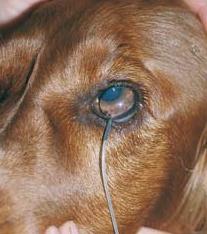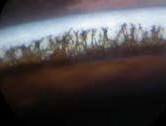


Working together with the
KENNEL CLUB
for a better future
KENNEL CLUB
for a better future
Eye Testing

The BVA/KC/Eye Scheme offers breeders the possibility of eye testing to screen for inherited eye disease in certain breeds. By screening breeding stock for these diseases, breeders can use the information to eliminate or reduce the frequency of eye disease being passed on to puppies. Although any breed can be examined for eye disease, currently only the results of those breeds that appear on Schedule A of the Eye Scheme are sent to the Kennel Club for inclusion on computer records and printing in the Breed Records Supplement (a Kennel Club publication). In general, the best age for eye testing is before a dog has reached one year old.
The Gonioscopy test is a REQUIREMENT for all Kennel Club Assured Breeders, it is carried out by a BVA Eye Specialist. This Gonioscopy test is only required to be done once in a dog's lifetime.
After finding a BVA Eye Specialist and making an appointment, you are instructed to take along the dog's KC registration certificate and the dog must has some form on permanent identification either a tattoo or microchip.
On arrival at your vet's surgery, you will be asked for your dog's paperwork it will be checked and retained by the vet until after the test has been completed upon where it will be returned to you, duly stamped.
You will be asked to accompany the vet into the surgery and you will be asked to place your dog on the vet's table. Once this is done, the vet will begin by putting some drops of water and/or anaesthetic into your dog's one eye and will then place a Gonioscopy lens onto the dog's eye; the water is to help create a vacuum to attach the lens.
The Gonioscopy test is a REQUIREMENT for all Kennel Club Assured Breeders, it is carried out by a BVA Eye Specialist. This Gonioscopy test is only required to be done once in a dog's lifetime.
After finding a BVA Eye Specialist and making an appointment, you are instructed to take along the dog's KC registration certificate and the dog must has some form on permanent identification either a tattoo or microchip.
On arrival at your vet's surgery, you will be asked for your dog's paperwork it will be checked and retained by the vet until after the test has been completed upon where it will be returned to you, duly stamped.
You will be asked to accompany the vet into the surgery and you will be asked to place your dog on the vet's table. Once this is done, the vet will begin by putting some drops of water and/or anaesthetic into your dog's one eye and will then place a Gonioscopy lens onto the dog's eye; the water is to help create a vacuum to attach the lens.
The lens is semi-circle made of a clear soft plastic, with a small length of pipe attached to a small pump as in the diagram right.


Gonioscopy lens (Barkan) in place. This allows the drainage angle to be examined directly using, for example, a slit lamp or direct ophthalmoscope
This is what the Vet is looking at.
(Right) The drainage angle is of normal width and is spanned by the pectinate ligament. In this poorly pigmented eye, the white band of the scleral shelf is clearly distinguished. There is great variation in the number, width, pigmentation and distribution of the fibres that comprise the pectinate ligament in different breeds, but the width of the normal drainage angle is not subject to such variation
(Right) The drainage angle is of normal width and is spanned by the pectinate ligament. In this poorly pigmented eye, the white band of the scleral shelf is clearly distinguished. There is great variation in the number, width, pigmentation and distribution of the fibres that comprise the pectinate ligament in different breeds, but the width of the normal drainage angle is not subject to such variation

(Left) Normal drainage angle. The width of the drainage angle is normal and the fibres of the pectinate ligament are clearly defined. This eye is more heavily pigmented than the one pictured on the left and the scleral shelf is obscured by pigment

(Right) Goniodysgenesis.There is extensive pectinate ligament dysplasia and sheets of mesenchymal tissue occlude the majority of the drainage angle. Aqueous drainage is via a limited number of ‘flow holes’ (an example of which is circled). The drainage angle is slightly narrowed and normal pigment obscures the scleral shelf.

The whole process for both eyes and filling in the relevant forms takes approximately 30 minutes or less.
Cornea
Scleral Shelf
Pectinate Ligament
Iris
Cornea
Iris
Pupil
Superficial Pigment Zone
Deep Pigment Zone
Deep Pigment Zone





Official site of the Basset Hound Health Group
The Basset Hound Health Group - is run under the auspices of all 8 UK based Basset Hound Breed Clubs
The Basset Hound Health Group - is run under the auspices of all 8 UK based Basset Hound Breed Clubs